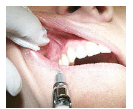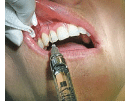What Type of Anesthetic Injections for SRP?
When providing selective scaling and root planing, what type of anesthetic injections would you recommend for a patient who has 5 mm to 7 mm pockets on the distal of #7 and the mesial of #4?
QUESTION: When providing selective scaling and root planing, what type of anesthetic injections would you recommend for a patient who has 5 mm to 7 mm pockets on the distal of #7 and the mesial of #4?
ANSWER: If only the tissue and teeth of #4 and #7 need anesthesia, you have two options: a middle superior alveolar (MSA) injection or an infiltration injection above #4. The MSA will anesthetize the mesial buccal root of the first molar and the pulpal and buccal soft tissue of the premolars. The infiltration will only anesthetize the tooth infiltrated and buccal soft tissue. I suggest you palpate the zygomatic process and the height of the mucobuccal fold above #4.

The primary difference between administering the MSA and an infiltration is the depth of insertion. For the MSA, insert the needle at the height of the mucobuccal fold between 4 mm to 10 mm or a quarter-inch to half-inch (Figure 1). If the zygomatic process does not allow for this depth of penetration, you may need to administer additional anesthetic solution. For an infiltration, insert and deposit the anesthetic at the apex of #4 using a short 27-gauge needle. The needle should be parallel with the periosteum/tooth and angled about 20° medially. Depending on the length of time and the duration of anesthesia needed, administer between half and two-thirds of a cartridge for profound anesthesia. Depending on the anesthetic agent chosen, you may need to administer a greater palatine injection for the mesial lingual tissue. I have found that articaine diffuses nicely on the maxilla, making a palatal injection unnecessary.

To anesthetize #7, I suggest administering either an anterior superior alveolar (ASA) or infiltration injection. The ASA will anesthetize the canine to the central incisor. Palpate the canine fossae (between the canine and lateral incisor) and the height of the mucobuccal fold. Insert a short 27-gauge needle at the height of the mucobuccal fold about 25° medially to the periosteum/tooth approximately 4 mm to 6 mm or a quarter-inch (Figure 2). For an infiltration, insert and deposit above #7 and deposit at the apex of #7. If the lingual tissues are sensitive, a nasopalatine injection may be needed. Articaine may diffuse enough to provide adequate anesthesia to the lingual tissue for scaling procedures.
The posterior superior alveolar (PSA) injection will anesthetize the molars (except the mesiobuccal root of the first molar) and associated buccal tissue. For profound anesthesia of the first molar, the PSA and the MSA or an infiltration above the first molar are often necessary.
From Dimensions of Dental Hygiene. May 2014;12(5):74.

